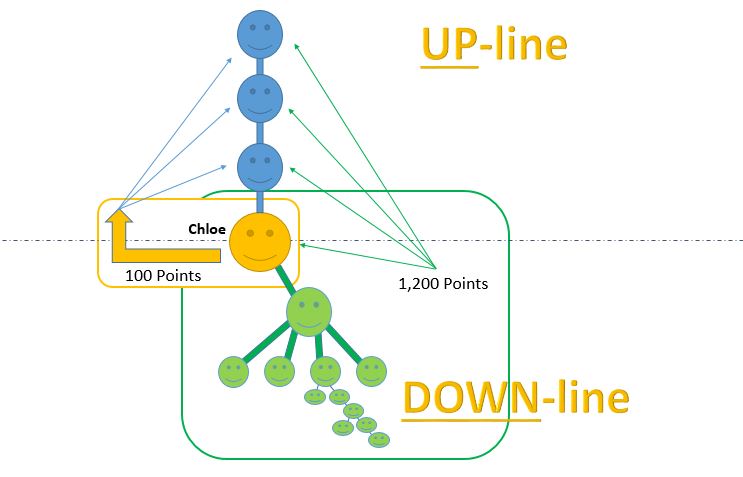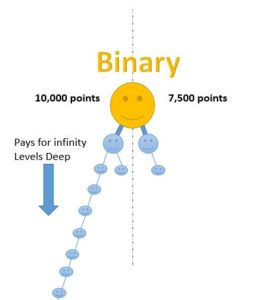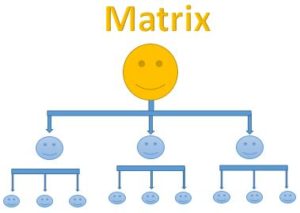What is network marketing (multi-level marketing, mlm, pyramid selling, referral marketing, and dual marketing), how does it work, and is it legit?
This business model has been praised by some and condemned by others.
One thing for sure, if you’re dealing with a legitimate network marketing company, it is NOT a scam.
There is big money to be made for producers.
Network Marketing Definition
Simply explained, network marketing is a business model that allows salespeople (commonly called distributors, consultants, business partners, or representatives) to be compensated for distributing products.
They do this by building large organizations of other customers and/or other salespeople.
Well, what exactly does that mean?
Basically it means that as product is ordered within your organization you get paid a little on A LOT.
Network Marketing Structure
Other industries use a similar compensation structures, such as real estate and insurance companies.
These companies allow their realtors and sales teams to earn commissions on the sales of the people they recruit.
It’s the same basic concept.
The direct selling association estimates revenue to be 35+ Billion per year in the US alone.
Compare this with industries such as the NFL, which has an annual revenue of 13 billion (1) and you can see that the industry is flourishing.
No doubt about it, network marketing is big business.
One of the main benefits of network marketing is that it provides a vehicle for anybody (regardless of education or position in life), to create a substantial income without needing a license or certification.
In This Article We’ll be Exploring Three Key Concepts:
- The History of Network Marketing (how did network marketing begin- short version)
- The Main Types of Network Marketing Compensation Plans
- How Those Various Compensation Plans Work
So if you’re curious about what network marketing is, it’s history, or how network marketing compensation plans work, keep reading.
It’s more interesting than you’d expect.
Let’s get started.
The History of Network Marketing
(Short Version)
The exact start of the multi-level marketing industry is sometimes disputed.
If you search online you’ll find subtle variations and dates from story to story.
This is due in part because the industry wasn’t really created on purpose, so it wasn’t documented as well as it should have been.


Network Marketing was born out of a California vitamin company that was formed in the 1930’s or 40’s.
It later became Nutrilite.
At some point, this company (Nutrilite) implemented a compensation plan that rewarded salespeople who recruited others to sell the products.
As the company grew and sales increased, two Nutrilite consultants, Jay Van Andel and Rich Devos realized (likely by accident) that the power of the compensation plan was really connected to building a large team of salespeople. (2).
After figuring this out, Rich Devos and Jay Van Andel planned and launched a company using the network marketing business model as it’s foundation.
This company was called Amway, which was an abbreviation for The American Way.
Amway was officially born in 1959.
Devos and Andel eventually bought out Nutrilite and the company continued to grow, eventually becoming one of the largest privately held companies in the world.
Amway gets a lot of bad press but you must keep in mind that they were the trailblazers.
They were figuring it out as they went.
Mistakes were made (just like in any new industry), but if it hadn’t been for Amway (which is now Quixtar in North America), the network marketing industry wouldn’t exist as we know it.
In fact, Amway’s winning defense of it’s business model against the FTC in 1979 (Amway vs. FTC) established the legitimacy of this industry and the corporate structure it uses.
It also proved to the world that it was NOT an illegal pyramid scheme.
How Do Network Marketing Compensation Plans Work – I mean, Really Work?


This is a loaded question but since I came up with it, I’ll attempt to answer it.
You really have to dissect how sales volume moves through an organization to get a firm grasp on the various compensation plans.
Once you understand sales volume, you can begin to understand how compensation is generated and how it’s possible for people to generate such large incomes in this industry.
Unfortunately, many people in the field don’t take the time to study and understand the network marketing business model so it’s often misunderstood and/or incorrectly explained.
One of the reasons for this is the catch-22 factor.
Network marketing’s greatest strength as a vehicle for building wealth is that anybody can do it.
That is also it’s greatest weakness (anybody can do it).
There are no prerequisites to get involved so there no barriers to entry.
This means sometimes idiots get in and drive the vehicle.
Usually they crash and burn and take innocent bystanders with them.
Before we get really granular about how the business model works, let’s go over some basic terms.
Different companies use different terms but I’ll cover the general ones for illustration purposes here.
It’s important that you understand that different companies use different names and different terminology.
For example, one company may refer to their distributors as consultants, associates, etc. while another company uses a different term altogether like “team builders”.
At the end of the day they are all salespeople and the high paid ones recruit other salespeople.
Basic Network Marketing Terminology
Points– Unit of measurement tied to product sales that allows a company to better calculate commissions
Volume– The amount of points that flow through an organization (attached to products)
Distributor– The owner of a business center
Business Center– A virtual position from which an organization is built
Downline– All distributors and business centers that stem from a particular person (business center). Basically, it’s your entire sales team and their sales teams and their sales teams, etc.
Upline– All distributors and business centers that are connected (above) a particular business center.
Legs– Individual teams that stem from a particular business center or person.
Generations– Levels below a particular business center. For example 2 levels down is also referred to as the 2nd generation.
Now that we have that taken care of, let’s move on to the nitty gritty.
The infographic below will help you better understand the basics of a typical multi-level compensation plan and how payouts are structured in this business model.
Everything in this graphic is centered around Chloe’s business center.


It’s a lot to take in at first glance.
I assure you it looks more complicated than it is but I wanted to fit enough in this example for you to get a good grasp of the basic compensation structure.
In almost all network marketing plans, points are generated based on sales volume.
An organization that stems from one distributor is referred to as a downline.
To better understand how this works, let’s name our salesperson and follow her story.


Chloe is a distributor.
The company Chloe belongs to is not important.
We will talk in generalities.
But for the purposes of this illustration, let’s give her parent company a name anyway- WIPE EASY, LLC.
Now let’s say this network marketing company Chloe has joined sells premium tissues made out of recycled adult diapers (oh yeah- who’s ready to sign up for that one?).
Each time Chloe puts in an order for tissues with her parent corporation WIPE EASY, LLC, her business center generates 100 points in commissionable volume.
That simply means that every time she orders, 100 points flow up through her organization, also known as her upline (opposite of downline).
Let’s go back to our infographic.


In the example here, you can see that 100 points flow to the business centers above her business center when she orders.
All the distributors above her benefit from her order by banking the points (like the old roll over points cell carriers used to have).
Likewise, every time her team or downline places an order (depicted in green), 100 points from each of them flows up through her business center as well as the business centers above her.
In this example, 1,200 points were generated for the pay period from her team.
I know this is a bit technical, but it’s important to understand, so stay with me.
The pay period depends on the company, just like in a job.
Jobs usually pay you for your work every week, two weeks, or month.
Again, it all depends on the job.
The same is true for a network marketing company- it depends on the company.
Some payout every week, some every month.
How Do Points Translate to Income?
There are different types of multi-level marketing compensation plans.
One thing they have in common is that points go into a business center and are calculated in a specific way.
There are two things that are usually part of this payout structure.
1) Points are translated to income based on a percentage or a cycle.
In most plans, a percentage of the points are calculated for commissions (i.e. 10% of points) or a number of points creates a cycle and that cycle has a dollar value (1 cycle = $25).
For example, you may get paid 10% of points, which in Chloe’s case would be $120 (10% of 1,200).
Another type of payout is based on cycles.
If Chloe’s compensation plan was based on cycles, maybe 200 points would constitute a cycle which would trigger a $20 payout.
If that was the case, her pay would be $120 as well because her volume (1,200) represents 6 cycles (200 x 6 = 1,200).
I find most people can understand these concepts if they take the time to.
The key is to understand the other requirements.
Obviously a company can’t pay everybody for all volume or there wouldn’t be enough money to go around.
They have to be able to attach that volume (and commissions) to the people who have earned it.
You earn it by being a point of origination.
I’ll get into that later.
This is where compensation plans get unique and also how companies ensure they have enough product sales to pay full commissions for those who earn them based on their teams sales volume.
The next section is why network marketing works and how distributors are able to create significant income.
2) Payouts are Continent Upon Company Specific Criteria.


At the end of the day, compensation plans consist of really well thought out mathematical equations.
For these equations to work, there must be enough volume generated by a specific business center to justify paying distributors for what they’ve produced.
I call this the point of origination or point of initial sale.
Companies usually do this by enacting some sort of criteria for triggering a payout.
These criterion not only allow the math to work, they also ensure that the people who are producing the most get paid the most.
That’s why top producers swear by the industry and those who do nothing hate it.
Just like 100% commission jobs in sales, if you don’t produce… you don’t get paid.
It’s part of the reason why network marketing has a bad reputation.
The system works…. if you do.
Unfortunately too many people are sold (by well meaning amateur distributors) on the idea that it will be easy.
It’s simple, but simple aint easy.
They come into the industry thinking they will start an organization and it will just take off so they can just sit back and get paid… forever.
That rarely happens by the way, but I digress.
Types of MLM Compensation Plans
Binary Compensation Plans


In a binary compensation plan, a business center has only two teams or legs.
Any and every person sponsored goes into one of the two teams.
All points flow up and to get paid, you must have a certain volume on one team (or leg) to justify getting paid on the other team (leg).
If it wasn’t setup like this, the math wouldn’t work because you’d be paying people who are just ordering product but not producing sales or recruiting.
You can have a leg (team) with 10,000 points on it and if you don’t produce on your other leg, you don’t get paid.
The strength of a binary compensation plan is in it’s simplicity.
In the example pictured, commissionable volume would be 7,500 points because that’s how many points are on the smaller or weaker leg.
Binary compensation plans are my favorite type of compensation plan because the math is so simple and it can literally pay to infinity.
I’ll repeat that, you get paid on depth to infinity in a binary compensation plan.
Not 3 levels, 5 levels, or 7 levels, but for infinite depth!
Let me repeat that one more time.
Regardless of how large your team grows, this compensation structure can calculate and payout infinite levels below you, as long as you have the matching volume on your other leg.
Why did I repeat that twice.
Because if you don’t understand the power in it, you will never see or understand the power of this business model.
It means if a superstar gets recruited into your team 1,500 levels down, you still get to benefit from the volume he or she creates.
Here’s an overview of our company’s binary plan that may be a little easier to understand, but most binaries have a very similar structure.
Note: Our CEO has recently changed from cycles to a straight 10% commission, which makes it even more profitable and quite a bit easier for people to understand.
I’ve left the video because it still does a good job of explaining how a binary plan with cycles would work.
UniLevel Compensation Plans


You sponsor people on the first level of your compensation plan and usually can build as many teams as you want.
This is called building “wide”.
One of the ways these plans ensure the math works out for points and volume is that typically they only pay for only a certain number of levels or generations.
So in a unilevel plan, you may be able to get paid for 5 generations (or levels) down.
The problem with this plan for a distributor though, is that if a superstar enrolls and he or she is seven generations deep, you wouldn’t get paid on that volume if your company only pays down five generations.
Just something to think about.
Matrix Compensation Plans


In a matrix plan, sometimes referred to as a forced matrix, the structure is like a grid because your goal is to fill in your grid.
Since you can only sponsor so many people on your frontline, you then have to place distributors in other open positions.
This helps fill up your grid and also helps fill up the grid of other people in your organization.
The problem with this plan is that when people get something for nothing, they start to expect it.
If you’re going to fill up my grid for me, what’s the point of me doing it?
It creates an organization of entitled distributors and nobody likes entitlement- except the person who feels entitled.
Plus, it’s really frustrating for the producers.
There haven’t been a lot of matrix plans that have survived and my personal belief is that it’s because even though this plan is very simple, it doesn’t factor in human psychology, which is not simple at all.
This compensation plan seems exciting for the lazy person and de-motivating for somebody who really wants to produce and earn.
You want your producers to be excited and motivated by the compensation model, otherwise nothing happens.
Stair Step Breakaway Compensation Plans


When they hit this level and do this, they typically receive more of their income and their sponsor receives less.
This takes care of some of the motivation issue in a unilevel plan because there’s a benefit to building a large organization and breaking away from the person who enrolled you.
However, it isn’t very team friendly because it means if you sponsor somebody, you want them to do well… but not too well.
Additionally, since breaking away is usually tied in some way to volume, this plan can entice people to purchase far more volume than they need in order to rise in rank and break away from their sponsor.
While that may be good for the parent company, it’s not good for the person who ends up with a garage full of unnecessary inventory.
This is just the tip of the iceberg when it comes to how mlm compensation plans work.
There are many intricacies to each compensation plan and each company structures them a bit differently.
If you join a company, be sure to review their compensation plan thoroughly and make sure you understand it.
Additional Rewards, Bonuses, and Incentives


Volume and calculation of points (translated to distributor payouts and commissions) are the foundations of how a distributor creates considerable income in network marketing.
However, companies usually offer other incentives and rewards as well to help keep distributors motivated to continue producing.
These opportunities may include any or all of the following:
- Bonuses for first orders (from customers or new distributors)
- Retail Sales
- Matching bonuses (on commissions from your downline)
- Leadership pools – A percentage of payout based on the sales volume of the entire company. Typically you must meet certain criteria to participate in these.
- Company Profit Sharing Programs- Typically paid on the company’s global volume. Again, you must maintain specific criteria for participation.
- Rank Advancement Bonuses – Bonuses paid when you achieve certain ranks within a company.
- Incentive Trips – Trips you can earn by meeting certain criteria or ranks.
- Exotic Cars – Many companies offer cars (usually a paid up lease) to distributors who earn a certain rank. The pink Cadillac by Mary Kay is perhaps the most famous.
Hopefully this post answered your question about “what network marketing is“ (at least at a basic level) and helped you understand the four main types of network marketing compensation plans.
If you’ve recently come to the realization that you need to do something different to reach your financial goals and are considering network marketing, please explore this site some more.
We have some great articles on the topic and we’ve found that the network marketing business model is a fantastic option for building wealth, especially if you utilize technology and social media.
You may want to consider the benefits and if you decide it may be an option for you, connect with us to see if our team is right for you.
If nothing changes… nothing changes.
We wish you ultimate success in your journey!
If you’d like to have a personal relationship with Jesus Christ, take a moment to visit our salvation page.
– Jason & Daniele







I’m new to all of this(ie. clueless) & I’m in contact with distributors who will sponsor me; what are the questions that i should be asking them as far as the business systematization and how it applies to me. What are the compensation plans & how does it apply to me? How do I apply emulate their business systematization & compensation plans through out my marketing activities? in addition; my business rule is as follows;i I continually educate Myself, I care about helping others.There are No Limits to my income, and systematizing all interpersonal, personal , business & social activities. I’m willing to learn and appreciate the advice & support
Michael,
Thanks for the questions. To be honest, I think you’re over thinking it. Experience is the best teacher. There is no magic system, there is no magic bullet that will make you successful, it comes down to you, your work ethic, and your leadership ability. There are some things you want to keep in mind when choosing a company though.
1) Decide on the compensation structure you like. I am a firm believer in binary compensation plans because I feel even average people can create extraordinary income with them.
2) Look at the Corporate Leadership (do they have experience, can you count on them to ship on time and pay on time and be ethical, especially in regards to FTC compliance so they don’t get shut down)
3) Find an upline (distributor/sponsor) you want to work with and who is building the way you want to build (i.e. online, social media, face to face, home parties, etc.).
If you’d like to hop on the phone so I can dive deeper into some of this stuff please reach out to me and maybe I can point you in the right direction.